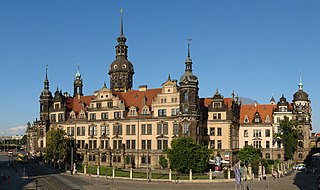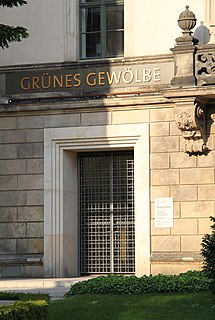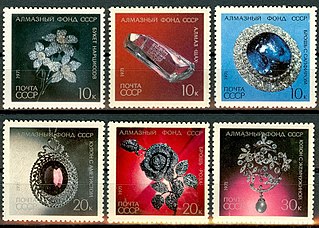
The Dresden Green Diamond, also known as "Dresden Green", is a 41 carats (8.2 g) natural green diamond, which probably originated in the Kollur mine in the state of Andhra Pradesh in India.

The French Crown Jewels comprise the crowns, orb, sceptres, diadems and jewels that were symbols of Royal power between 752 and 1825. These were worn by many Kings and Queens of France. The set was finally broken up, with most of it sold off in 1885 by the Third French Republic. The surviving French Crown Jewels, principally a set of historic crowns, diadems and parures, are mainly on display in the Galerie d'Apollon of the Louvre, France's premier museum and former royal palace, together with the Regent Diamond, the Sancy Diamond and the 105-carat (21.0 g) Côte-de-Bretagne red spinel, carved into the form of a dragon. In addition, some gemstones and jewels are on display in the Treasury vault of the Mineralogy gallery in the National Museum of Natural History.

Schatzkammer, a German word which means "treasury" or "treasure chamber", is a term sometimes used in English for the collection of treasures, especially objets d’art in precious metals and jewels, of a ruler or other collector which are kept in a secure room and often found in the basement of a palace or castle. It also often included the wider types of object typical of the Renaissance cabinet of curiosities. A very small but evocative Renaissance room in a tower at Lacock Abbey was designed for keeping and viewing the treasures of the newly rich owner.

The Iranian National Jewels, originally the Iranian Crown Jewels, include elaborate crowns, thirty tiaras, and numerous aigrettes, a dozen bejeweled swords and shields, a number of unset precious gems, numerous plates and other dining services cast in precious metals and encrusted with gems, and several other more unusual items collected or worn by the Persian monarchs from the 16th century and on. The collection is housed at The Treasury of National Jewels, situated inside the Central Bank of Iran on Tehran's Ferdowsi Avenue.
Named after The Pink Panther series of crime comedy films, Pink Panthers is the name given by Interpol to an international jewel thief network, consisting of 200-250 members from Serbia, Montenegro, Croatia, Macedonia and Bosnia and Herzegovina. The organization is responsible for some of the most audacious thefts in the history of theft and organized crime. They are responsible for what have been termed some of the most glamorous heists ever, and one criminologist even described their crimes as "artistry". They have operated in numerous countries and on several continents, and include Japan's most successful robbery amongst their thefts. A film documentary based upon their thefts, Smash & Grab, was released on 2 July 2013.

Johann Melchior Dinglinger was one of Europe's greatest goldsmiths, whose major works for the elector of Saxony, Augustus the Strong, survived in the Grünes Gewölbe, Dresden. Dinglinger was the last goldsmith to work on the grand scale of Benvenuto Cellini and Wenzel Jamnitzer, fewer of whose large-scale works in precious materials have survived, however. His work carries on in a Mannerist tradition into the "Age of Rococo".

Dresden Castle or Royal Palace is one of the oldest buildings in Dresden, Germany. For almost 400 years, it was the residence of the electors (1547–1806) and kings (1806–1918) of Saxony from the Albertine House of Wettin as well as Kings of Poland (1697–1763). It is known for the different architectural styles employed, from Baroque to Neo-renaissance.

The Green Vault is a museum located in Dresden, Germany, which contains the largest treasure collection in Europe. The museum was founded in 1723 by Augustus the Strong of Poland and Saxony, and it features a variety of exhibits in styles from Baroque to Classicism. The Green Vault is named after the formerly malachite green painted column bases and capitals of the initial rooms. It has some claim to be the oldest museum in the world; it is older than the British Museum, opened in 1759, but the Vatican Museums date their foundation to the public display of the newly excavated Laocoön group in 1506.

Staatliche Kunstsammlungen Dresden is a cultural institution in Dresden, Germany, owned by the State of Saxony. It is one of the most renowned and oldest museum institutions in the world, originating from the collections of the Saxon electors in the 16th century.

The Diamond Fund is a unique collection of gems, jewelry and natural nuggets, which are stored and exhibited in the Kremlin Armoury in Russia. The Fund was opened in 1967 and its collection dates back to the Russian Crown treasury instituted by Emperor Peter I of Russia in 1719. It is a part of Moscow Kremlin Museums.

The Jewels of the Nizams of Hyderabad State are among the largest and most expensive collection of jewels in present-day India. The jewels belonged to the Nizams. After the annexation of their kingdom by Union of India, the Nizam and his heirs were barred by the Indian government from taking the collection, claiming that it was a national treasure.
The Blue Diamond Affair is a series of unresolved crimes and embittered diplomatic relations triggered by the 1989 theft of gems belonging to the House of Saud by a Thai employee. The affair has soured relations between Saudi Arabia and Thailand for over 30 years.

The Nassak Diamond is a large, 43.38 carats (8.676 g) diamond that originated as a larger 89 carat diamond in the 15th century in India. Found in Golconda mines of Kollur and originally cut in India, the diamond was the adornment in the Trimbakeshwar Shiva Temple, near Nashik, in the state of Maharashtra, India from at least 1500 to 1817. The British East India Company captured the diamond through the Third Anglo-Maratha War and sold it to British jewellers Rundell and Bridge in 1818. Rundell and Bridge recut the diamond in 1818, after which it made its way into the handle of the 1st Marquess of Westminster's dress sword.
Maharani Sita Devi Sahib of Baroda, born to Telugu family on 12 May 1917 in Madras, India, died 15 February 1989 in Paris, France. She was known as the "Indian Wallis Simpson". She was a colourful lady who led an extravagant life for over 40 years and was a member of the international jet set.

The Graff Diamonds robbery took place on 6 August 2009 when two men posing as customers entered the premises of Graff Diamonds in New Bond Street, London and stole jewellery worth nearly £40 million. It was believed to be the largest ever gems heist in Britain at the time, and the second largest British robbery after the £53 million raid on a Securitas depot in Kent in 2006. The thieves' haul totalled 43 items of jewellery, consisting of rings, bracelets, necklaces and wristwatches. One necklace alone has been reported as being worth more than £3.5m. Britain's previous largest jewellery robbery also took place at Graff's, in 2003.
Graff is a British multinational jeweller based in London. It was founded by British jeweller Laurence Graff in 1960. A vertically integrated company, Graff operations comprise the design, manufacture and retail distribution of jewellery and watches.
Vojislav Stanimirović is a Serbian journalist and one-time crime figure, most famous for his leading role in The Vizcaya Heist. He emigrated to the United States in 1952. Vojislav Stanimirović was also later involved with YACS and the Pink Panthers among Serbian mafia figures. He is the father of Pavle Stanimirović.

In April 2015, the Hatton Garden Safe Deposit Company, an underground safe deposit facility in London's Hatton Garden area, was burgled. The total stolen may have a value of up to £200 million, and the incident has been called the "largest burglary in British legal history". The heist was planned and carried out by six elderly men who were experienced thieves, all of whom pleaded guilty and received prison sentences in March 2016. Four other men were also tried on suspicion of involvement; three were found guilty and sent to prison, while the fourth was cleared.
The Dresden White Diamond is a 49.71-carat (9.942 g) cushion-cut diamond that probably originated from the Golconda mines in Southern India.














